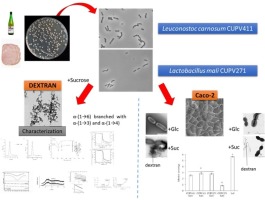当前位置:
X-MOL 学术
›
Food Hydrocoll.
›
论文详情
Our official English website, www.x-mol.net, welcomes your feedback! (Note: you will need to create a separate account there.)
Characterization of dextrans produced by Lactobacillus mali CUPV271 and Leuconostoc carnosum CUPV411
Food Hydrocolloids ( IF 10.7 ) Pub Date : 2019-04-01 , DOI: 10.1016/j.foodhyd.2018.10.053 María Goretti Llamas-Arriba , Ana I. Puertas , Alicia Prieto , Paloma López , Mónica Cobos , José I. Miranda , Cristina Marieta , Patricia Ruas-Madiedo , Ma Teresa Dueñas
Food Hydrocolloids ( IF 10.7 ) Pub Date : 2019-04-01 , DOI: 10.1016/j.foodhyd.2018.10.053 María Goretti Llamas-Arriba , Ana I. Puertas , Alicia Prieto , Paloma López , Mónica Cobos , José I. Miranda , Cristina Marieta , Patricia Ruas-Madiedo , Ma Teresa Dueñas

|
Abstract The exopolysaccharide (EPS)-producing Lactobacillus mali CUPV271 and Leuconostoc carnosum CUPV411 were isolated from Spanish ropy apple must and slimy ham, respectively. The polymers were purified from bacterial cultures’ supernatants and subjected to physicochemical and rheological characterization with the aim to evaluate their potential for future industrial utilization. Methylation analysis, Fourier-Transform Infrared Spectroscopy (FT-IR) and Nuclear Magnetic Resonance (NMR) revealed that both polymers were dextrans, partially branched at O-3 and O-4 positions of the main α-(1 → 6)- d -glucopyranose backbone. The molar masses of the EPS of L. mali and Lc. carnosum were of 1.23 × 108 g/mol and 3.58 × 108 g/mol, respectively. The bacterial strains were tested for binding to the human Caco-2 cell line in the presence and absence of their respective dextran, revealing that the EPS production by L. mali decreased the binding capacity of the bacterium while the adhesiveness of Lc. carnosum did not change. As the structure and molecular mass of both dextrans were comparable, other characteristics of the dextrans were studied to explain this behavior. Atomic force micrographs showed some differences at the supramolecular level, suggesting that the different spatial distribution of the dextrans might be on the basis of the results of the adhesion studies. Both polysaccharides resulted to be amorphous materials with Tg around 226 °C and showed slightly different thermal degradation patterns. Rheologically, they showed to have a pseudoplastic behavior, but very different critical concentrations: 3.8% for the EPS of L. mali and 0.4% for that of Lc. carnosum.
中文翻译:

马里乳杆菌 CUPV271 和肉明串珠 CUPV411 产生的葡聚糖的表征
摘要 分别从西班牙粘苹果汁和粘糊糊的火腿中分离得到产胞外多糖 (EPS) 的马里乳杆菌 CUPV271 和肉明串珠菌 CUPV411。从细菌培养物的上清液中纯化聚合物,并对其进行物理化学和流变学表征,目的是评估它们在未来工业应用中的潜力。甲基化分析、傅里叶变换红外光谱 (FT-IR) 和核磁共振 (NMR) 显示两种聚合物都是葡聚糖,在主要 α-(1 → 6)- d 的 O-3 和 O-4 位置部分支化-吡喃葡萄糖骨架。L. mali 和 Lc 的 EPS 的摩尔质量。carnosum 分别为 1.23 × 108 g/mol 和 3.58 × 108 g/mol。在存在和不存在各自的葡聚糖的情况下,测试了细菌菌株与人 Caco-2 细胞系的结合,表明 L. mali 产生的 EPS 降低了细菌的结合能力,而 Lc 的粘附性。carnosum 没有改变。由于两种葡聚糖的结构和分子量相当,因此研究了葡聚糖的其他特性来解释这种行为。原子力显微照片在超分子水平上显示出一些差异,表明葡聚糖的不同空间分布可能是基于粘附研究的结果。两种多糖都是无定形材料,Tg 约为 226 °C,热降解模式略有不同。在流变学上,它们表现出假塑性行为,但临界浓度非常不同:L. mali 的 EPS 为 3.8%,Lc 的 EPS 为 0.4%。肉桂。
更新日期:2019-04-01
中文翻译:

马里乳杆菌 CUPV271 和肉明串珠 CUPV411 产生的葡聚糖的表征
摘要 分别从西班牙粘苹果汁和粘糊糊的火腿中分离得到产胞外多糖 (EPS) 的马里乳杆菌 CUPV271 和肉明串珠菌 CUPV411。从细菌培养物的上清液中纯化聚合物,并对其进行物理化学和流变学表征,目的是评估它们在未来工业应用中的潜力。甲基化分析、傅里叶变换红外光谱 (FT-IR) 和核磁共振 (NMR) 显示两种聚合物都是葡聚糖,在主要 α-(1 → 6)- d 的 O-3 和 O-4 位置部分支化-吡喃葡萄糖骨架。L. mali 和 Lc 的 EPS 的摩尔质量。carnosum 分别为 1.23 × 108 g/mol 和 3.58 × 108 g/mol。在存在和不存在各自的葡聚糖的情况下,测试了细菌菌株与人 Caco-2 细胞系的结合,表明 L. mali 产生的 EPS 降低了细菌的结合能力,而 Lc 的粘附性。carnosum 没有改变。由于两种葡聚糖的结构和分子量相当,因此研究了葡聚糖的其他特性来解释这种行为。原子力显微照片在超分子水平上显示出一些差异,表明葡聚糖的不同空间分布可能是基于粘附研究的结果。两种多糖都是无定形材料,Tg 约为 226 °C,热降解模式略有不同。在流变学上,它们表现出假塑性行为,但临界浓度非常不同:L. mali 的 EPS 为 3.8%,Lc 的 EPS 为 0.4%。肉桂。


























 京公网安备 11010802027423号
京公网安备 11010802027423号